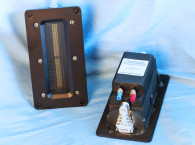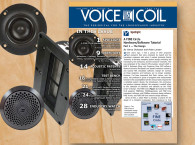Fountek was founded in April 2003 with a mission to supply strictly high-end two-channel products. The company released its first ribbon transducer, the JP3.0, in June 2003, followed by its JP2.0 ribbon transducer in October 2003, and its NeoPro 5i released in October 2004 and later its NeoX 3.0 ribbon, which was featured in the July 2016 issue of Voice Coil magazine.
The device that Fountek sent to us this month is the company’s current iteration of its NeoPro 5i ribbon tweeter (Photo 1 and Photo 2). The NeoPro 5i utilizes a 145mm × 15mm, 0.015mm thick reinforced sandwich (2175mm2 radiating area) ribbon diaphragm. You can also see that the NeoPro 5i uses a closed-back injection-molded rear cavity with two aluminum heatsinks and a built-in transformer. Other features for this design include the neodymium motor system, a cosmetically attractive 190mm × 115mm, 0.25” thick black aluminum face plate, a black mesh screen protecting the diaphragm, with 100dB 2.83V/1m sensitivity, rated 60W nominal power handing (120W maximum), a recommended crossover frequency of 1.5kHz at 24dB/octave, and a pair of gold-plated color-coded binding post for terminals. This is a fairly heavy high-frequency device, weighing in at 5lbs 10oz.


I commenced analysis for the Fountek NeoPro 5i by performing a 300-point impedance curve depicted in Figure 1, using the legacy LinearX LMS (RIP Chris Strahm). The primary resonance occurs at 250Hz with a small secondary resonance at 670Hz. Measured DCR for the NeoPro 5i is 0.19Ω, which is typical of this kind of transformer coupled ribbon device. This is not an issue once a crossover is applied; however, you need to be aware of this when you are characterizing this type of transducer and limit your analyzer’s frequency range to about 100Hz. The minimum impedance above the primary resonance was a normal 5.31Ω at 2.71kHz.

Following the impedance measurement, I mounted the NeoPro 5i in an enclosure with a 18”×10” baffle area and proceeded to measure the on- and off-axis SPL with sweeps at 0°, 15°, 30°, and 45° on- and off-axis frequency response, using the Loudsoft FINE R+D FFT analyzer (courtesy of Loudsoft) and the GRAS 46BE ¼” microphone (provided by GRAS Sound & Vibration). The instrument was set up to measure the 200Hz to 40kHz frequency response (using a 192kHz sampling rate) at 2V/0.5m, normalized to 2.83V/1m. Data was then taken in both the horizontal and vertical planes. Figure 2 shows the horizontal on-axis response of the Fountek ribbon transducer. The frequency response of the NeoPro 5i is ±2dB from 1.5kHz to 8.5kHz and ±3.5dB from 1.5kHz to 40kHz. There is some peaking in the response centered on about 12kHz, so some equalization would be useful.

Figure 3 depicts the on- and off-axis frequency response in the horizontal plane, which is somewhat like the typical directivity of a 1” dome tweeter. Figure 4 shows the normalized 0° to 45° frequency response. Figure 5 depicts the CLIO Pocket-generated horizontal polar plot (with 1/3 octave smoothing applied). Because the aspect ratio of the NeoPro 5i aperture is similar to most ribbons and AMTs, there is substantial directivity in the vertical plane. This can be seen in the vertical plane for the on- and off-axis 0° to 45° curves depicted in Figure 6, the same curves normalized shown in Figure 7, and the vertical polar plot shown in Figure 8. Figure 9 provides the two-sample SPL comparison, indicating that both NeoPro 5i samples were closely matched within the relevant operating range with about a 2dB variation in a narrow range between 6kHz to 8kHz.

45° = purple).






For the last group of measurements, I fired up the Listen SoundCheck analyzer (SoundCheck 20 software) with the SCM microphone, and AudioConnect USB interface (all provided courtesy of Listen, Inc.). With the SPL set to 94dB/1m (1.70V) using the built in pink noise generator and SLM utilities, I then relocated the ¼” SCM microphone to 10cm from the face plate of the Fountek NeoPro 5i and ran the distortion curves, which are shown in Figure 10. Note that the stimulus was limited to 1.5kHz as its lowest frequency.

For the last two measurements, I performed an impulse measurement, and then imported the data into the Listen SoundMap software, windowed out the room reflections, and created the cumulative spectral decay (CSD) plot depicted in Figure 11 and the Short-Term Fourier Transform (STFT) shown in Figure 12.


Ribbon and AMT high-frequency devices are known for good transient performance and clarity in the vocal range. Looking at the data collected for the Fountek NeoPro 5i, along with its excellent build quality, I think the NeoPro 5i would make an effective high-frequency device for use in a two-way system incorporating 8” to 10” woofers. For more information, visit www.fountek.net. VC
This article was originally published in Voice Coil, July 2023.







